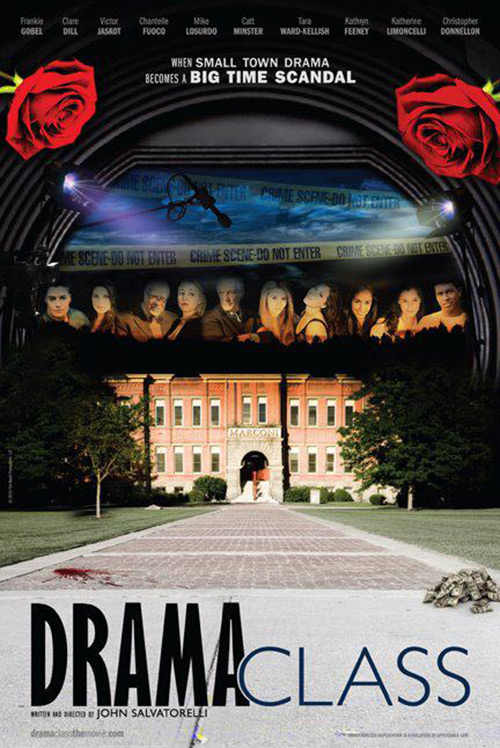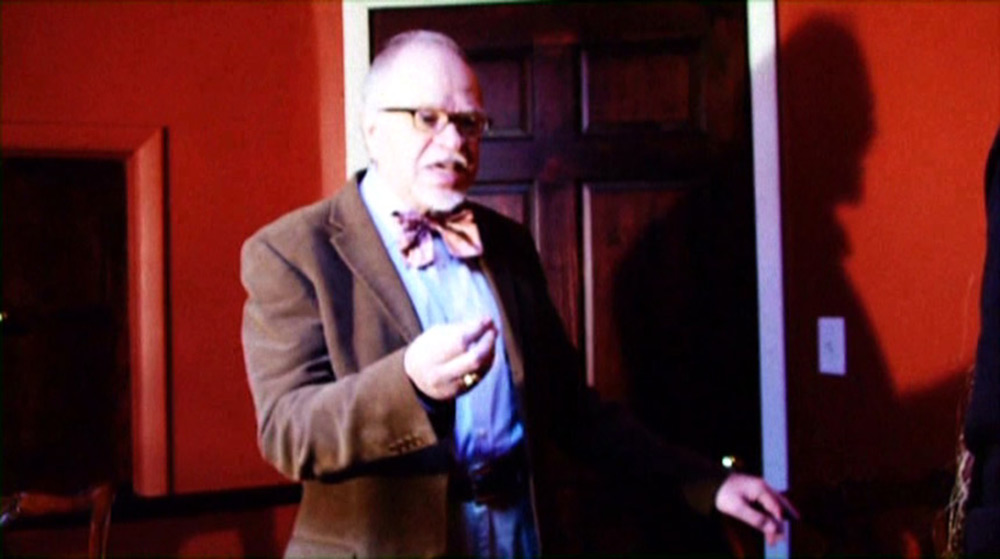Feature Film Critique
DramaClass
 Director: John Salvatorelli
Director: John Salvatorelli
Expected Rating: PG due to suspense and risqué scenes
Distribution: None
Budget: $30,000
Genre: Comedy
Release Date: October 2011
Official Website: Dramaclassthemovie.com
Trailer: Dramaclassthemovie.com
Running Time: 90 minutes
Review Issue: Issue #75 (April 2012)
Reviewed By: Jeremy Hanke
Final Score: 3.0
When a television studio of ill repute decides they need to one-up their already questionable line of reality shows, they decide to create a reality show set in a tiny college that’s owned by Barbara Marconi, the barely legal wife of a millionaire. As the reality show gets ready to shoot, things come to a head between Mrs. Marconi, her current beau, her husband, and his enforcer. At the same time, students Bret, Meghan, Jen, Danielle, Sarah, Liz, and Billy must figure out what they want to be and how it interacts with their dramatic aspirations. Only time will tell what happens when everything hits all at once…
Content
Mr. Salvatorelli and company clearly wanted to create a caper film that used a local high school (the lockers made it pretty clear that it wasn’t actually a college) and a drama class as its main set pieces. The idea seems to be something along the lines of the high school thriller Brick meets the TV show, Glee (with a bit of the Jersey Shore thrown in, as well). Unfortunately, there are some real problems with achieving these aspirations.
The writing is currently quite confusing, with too many plot points to keep track of and too many characters to sort through. In addition to the television show plot device, there are a plethora of intertwined stories. How intertwined? Well, the multiple love triangles of Mrs. Marconi intertwine with a police investigation, which intertwines with stalkers who aren’t really the stalkers you thought they were (but are really other stalkers), which intertwines with students who aren’t police but are allowed to go on ridealongs with the cops and behave sort of like they’re police, which intertwines with sorority pranks that appear to exist only for a bra-and-panty pillow fight scene, which intertwines with a slew of scuzzy low-life’s selling merchandise and information, which intertwines with Mr. Marconi’s antics to try and kill Mrs. Marconi, which, finally, intertwines with a sleazy plastic surgeon who just wants the love of his life back. All of this intertwining is exhausting to the audience.
For the future, the number one thing I would encourage Mr. Salvatorelli with is to simplify the story he’s trying to tell. Boil things down to the most basic elements of the story and see how much one can tell with as little as possible! Start with three or four characters and make a movie that works in only one location. Once you refine your ability to tell a story with few characters in a simple location, then you can begin to add more locations and characters. Even so, it’s wise to keep the number of characters in a low-budget film to no more than 10 and the same with locations. (On a black belt level for this concept, filmmaker Mike Flanagan made a riveting tale of fear called Oculus that was set in a single room, with a single actor, a mirror, a cell phone, and a flickering light. I would recommend that any filmmaker watch Oculus, which Mike kindly allowed us to host a copy of here, for inspiration.)
Currently the acting feels very stilted and campy. Now, if the actors in this film were from a stage drama troupe, rather than experienced screen actors, then this may be due to the fact that they’re trying to do stage acting, rather than screen acting. Stage acting is much more overt and stylized, so that it can be perceived and understood by as many people as possible in an auditorium. Screen acting is much more subtle, since the camera can get in on people’s faces.
The current editing of the film doesn’t help the audience to understand what’s going on, either. There are numerous jump edits that go between scenes that can make you think things are happening in ways that they really aren’t. While this was clearly done to add mystery to the film, it’s more likely to cause the audience lose patience. Additionally, there’s a plethora of stylized transitions—like clock wipes and page peels—that are quite distracting.
As with the writing itself, I would encourage the filmmaking team to simplify what they are doing with the editing, especially the transitions. Remember that 80% of transitions in professional films are simply cuts, with the other 20% typically being dissolves (most often used in montages) and dips to black (often used in scene conclusions or in stylized ways of showing passing consciousness).
Finally, the ending is quite convoluted and, while it feels like it might work as the ending for some film, does not seem to work for this film. Again, I think that, for future films, if more care is put into simplifying the film, this will not be a problem.
Visual Look
The camera used for this film was a Sony HVR-HD camera which is a prosumer camera, which means they had a fair number of options they could bring to the table over a simple consumer camera. They chose to shoot it entirely handheld, perhaps to save time or to make things more gritty. (If it’s the latter, then it might’ve been to replicate the cinematography most often associated with Paul Greengrass films.)
Unfortunately, it didn’t seem like the creative team was very familiar with the camera they were using, as they failed to shut off auto-gain, nor did they seem familiar with how much light it takes to properly expose a scene. This is very crucial to understand with digital cameras, which have very little light latitude (in comparison to something like film). What this means is that if you shoot with too little light, the image is chunky and unattractive and if you try to increase the brightness in post, the image completely falls apart. A little too much light and the scene blows out. Both issues were constantly in effect in this film, with very few times that a shot reached the happy medium.
While most of the film seems to have been shot with available lighting, there were times where direct lighting appears to have been applied to the scenes being filmed. In these scenes, however, because only a single, bright light source was used, it tended to blow out part of the actor’s face and leave a dark shadow behind the actor. Understanding triangle lighting is really necessary for low-budget filmmakers, so I would encourage the creative team to read the Set Lighting Technician’s Handbook that Lee Clements reviewed here awhile back.
Also in the visual department, there were a lot of jump cuts and breaking of the 180 degree rule that were very jarring. I would highly recommend that the creative team also pick up Hollywood CameraWork, which goes in-depth through all the basics of camerawork and effective editing of those shots to tell a story. (Because we’ve been so impressed with their training, MFM negotiated a 30% discount with HCW for our readers.)
Use of Audio
Perhaps for the sake of speed, the team recorded all of their dialogue (and even their narration) with the microphone that comes on top of the camera. This really is a problem, because the actors voices were very muddy (because of how far away from the camera they were) and the sound of the camera’s recording mechanism was constantly present. With any film project, be sure to always use a separate shotgun microphone that is both 2 to 3 feet from AND aimed at the speaking actors’ mouths. (For more on this, be sure to read our article: Audio Tips That Every MicroFilmmaker Needs.)
Additionally, one scene in a diner appeared to be recorded with all the refrigerators running, so the actors were trying to speak over the din of the equipment. Always remember to turn off the equipment whenever you’re recording a scene. If you can’t do so, it’s best to change where the scene is located.
Because of the problems with audio recording, the mixing of the audio was equally problematic, with people’s voices suddenly becoming unintelligible, and with a narrator that seemed almost farther away than the actors. While there is a limit to how much can be fixed in post, there are a few things that will definitely improve things. (You’ll notice that I’ll be mentioning iZotope products and that is quite frankly because, at MFM, we haven’t found any other products that work better, and we’ve tested a lot of the competitors!)
1) Run the entire dialogue track through one of iZotope’s cleaning programs. While RX2 would be best, they have a pretty good basic program called Music & Speech Cleaner that’s only $40.
2) Process your narration with iZotope Nectar, which is a program that really helps with vocals and spoken word. (You could also run your dialogue through it, just make sure you use the setting for dialogue for that and the one for narration for the narration.)
3) Mix your audio to the following industry standards: dialogue –12 dB, music/SFX beds –18 dB, discreet SFX/Narration – 6 dB.
Use of Budget
The $30K budget was used on insurance, travel, sets, wardrobe, the rental of an audition studio, the website, poster art, and food for the actors & actresses. While all of these are legitimate expenses in and of themselves, they’re a bit upside down when no money was put into lighting, audio, or hiring a camera operator who was familiar with the camera that was going to be used. For the future, if fewer locations and characters are used, the costs of insurance, food, and travel will go down and the money will be freed up for the all important audio and visual elements, as well. (As an FYI, most local libraries will allow you to do your auditions in their facilities free of charge, so long as you schedule it with them in advance and have a current library card.)
Lasting Appeal
Right now this film doesn’t have much lasting appeal. If the changes I suggest are made, the appeal will increase some, but a lot of re-editing would be needed to make the storyline more understandable and cohesive.
Overall Comment
I understand what it’s like to make a film that has problems, as my first film had a lot of issues as well, and it was so hard to move on after that. However, I firmly believe that Mr. Salvatorelli and his team can learn valuable lessons from their work on DramaClass. Down the road, as they build off these lessons, there’s nothing that can prevent them from being successful in filmmaking. To that end, I wish them the best of luck!
|
Breakdown
|
|
|
Content
|
3.0 |
|
Visual Look
|
3.0 |
|
Use of Audio
|
4.0 |
|
Use of Budget
|
4.0 |
|
Lasting Appeal
|
1.0 |
|
Overall Score |
3.0 |



